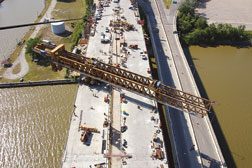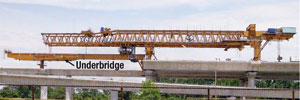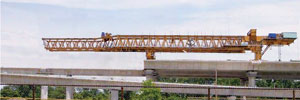 |
 |
| Regaining Stride. Maumee River crossing, now using a modified truss (right), will feature glass-sheathed pylon (top). (Rendering top courtesy of Figg; photo bottom courtesy of the Ohio DOT) |
Toledo’s Maumee River bridge, known officially as the Veterans Glass City Skyway, will be the second ever to utilize the cable cradle system designed by W. Denney Pate, principal bridge engineer with Figg Engineering Group, Tallahassee. After a fatal truss collapse halted work for 18 months, crews are now regaining momentum (ENR 3/1/04 p. 12).
Crews have completed six of 128 cantilevered segments for the 1,225-ft main span. They average 9.5 ft long, 58 ft wide and 12 ft deep, says Mike Gramza, Ohio Dept. of Transportation project manager. Ballwin, Mo.-based Fru-Con. Construction Corp. modified a 1.6-million-lb launching truss—originally the twin to the ill-fated one— in part by removing the underbridge portion. It is now completing approach spans. Fru-Con is also utilizing overhead launchers, an underslung launcher and a falsework system. A majority of 182 approach or ramp spans are complete, as are 10 backspans, says Gramza.
The Interstate 280 crossing’s $220-million cost has risen to $234 million. Fru-Con was one year ahead of schedule before the accident and is now working to make up the six months. Full completion is slated for fall 2007, but ODOT and Fru-Con hope to shave some time off that. As of May 16, Fru-Con faces $10,000 a day in late penalties, says Gramza. It will face $20,000 a day as of Dec. 27.
|
Some time could be saved by installing 196 ft worth of 4.5 x 7.5-ft, 500-lb glass panels on the 404-ft-tall pylon soon, rather than waiting until the main span is complete. “The designers and the glass manufacturers are assessing if the glass can accommodate pylon deflections that will occur during construction,” says Fru-Con project director David Herron.
 |
 |
| Modified. Remaining truss (top) was simplified by removing the underbridge portion (bottom). It is placing approach spans. (Photos courtesy of the Ohio DOT) |
Fru-Con engineers visited the Penobscot bridge in April to view its cable cradle system, says Herron. “The Penobscot bridge is a cast in situ superstructure, the stays are much smaller and they don’t use a stainless steel sheath, so there are many differences,” he says. The number of strands per stay in the Maumee bridge is as high as 156, as compared to a maximum of 73 for Penobscot. But the strand installation is similar. “We were able to verify the productivities,” says Herron.
Based on its visit, Fru-Con might enlarge 8-in. openings in the Maumee cradles to about 20 in. to ease access to the cheese plates.
